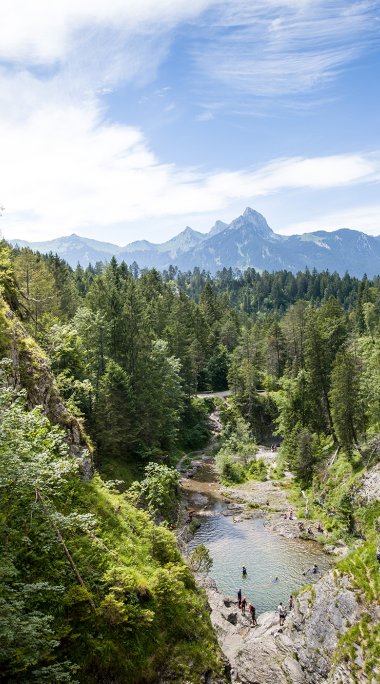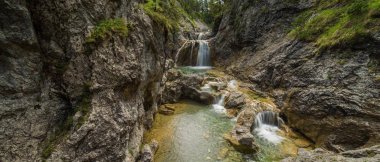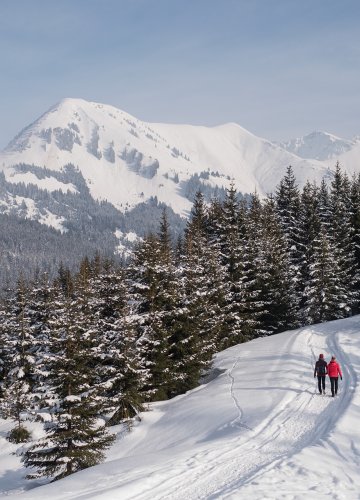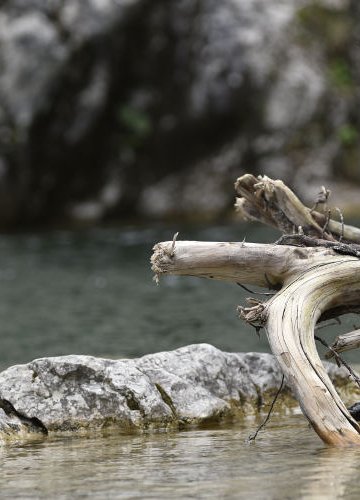Stuiben Falls History
In 1756 the Stuiben Falls are mentioned in the description of the rural chapter (deanery) of Füssen (available in the parish and deanery archives of Breitenwang). There is nothing romantic about this description, but something threatening, because it was a matter of life and death, because the wood from the Plansee area had to be drifted over them.
One reads that "several hundred fathoms of wood" (1 fathom = 1.897 m³) were drifted over the Plansee and the Planseeache every year for burning and building. In doing so, the threatening Stuiben Falls had to be overcome. The great Stuibenfall is described as a "precipitous drop at the height of a church steeple", in which many people have lost their lives. The legend tells us about numerous ghosts in Reutte and its surroundings. In order to banish them, a Capuchin priest was brought in at that time, who banished the spirits to the Stuibenfälle. Thus, in popular belief, the Stuiben Falls once again acquired something threatening.
They are described differently already in 1783 in the description of the former spa Kreckelmoos. Here the Stuiben Falls are described as a worthwhile destination for the visitors of this spa. One reads:
(Description of the Daurenhofer Sauerbrunnen and the so-called Krecklmoser Bad near Reutti in Tyrol. Together with an appendix for physicians and an outline of the bathhouse. Published by Peter Paul Mayr, doctor of philosophy and medicine, and physicist at Reutti. 1783)
This description could also be seen as the first illustrated advertising brochure for Reutte.
The Stuiben Falls in historic Tyrol
From 1806 to 1814, Tyrol belonged to the Kingdom of Bavaria. In 1808, the Stuiben Falls received their first royal visit. When the Bavarian crown prince, the future King Ludwig I, was traveling through Reutte, he interrupted his trip and paid a visit to the Stuiben Falls (Parish Chronicle Breitenwang). This indicates that the Stuiben Falls were already known in the highest circles as a natural wonder at that time.
With the Romantic period and the associated awakening of enthusiasm for nature, the Stuiben Falls increasingly became the focus of attention for new groups of visitors. Forgotten was the life-threatening wooden drift, forgotten were also the spirits banished in the Stuibenfälle. A completely new, nature-loving image emerged. The Stuibenfälle were increasingly sung about in poems.
The oldest known poem dates back to 1838, when Karl von Samern, an imperial official working in Reutte, poetically sings about Reutte and its surroundings, including the Stuibenfall:
Its water rushes down in two famous falls
And supplies for the table the most delicious trout.
The strangers hardly arrive, so everyone asks:
Who leads us? Where is the way to the waterfall?
It is really worth the effort to hurry there,
For once there, one wishes to stay there for a long time.
The waterfall deserves its own poem,
But even the best will not describe it truly.
Only one thing: immediately the colorful light of the iris appears,
When in the waterfall the ray of the Phoebus breaks.
Such poetic descriptions are now becoming more frequent.
In addition, there are pictorial representations, first as engravings and later with the advent of picture postcards in an almost unmanageable number. At that time, there was no continuous path over the Stuiben Falls to the Plansee. This was probably the reason that Beda Weber did not mention the Stuiben Falls in his 1838 hike (Das Land Tirol. Ein Handbuch für Reisende, 1837, 1838), but did mention in detail the Plansee "umsungen von zahllosen Vögeln und tausendstimmigem Widerhall".
In 1842, Ludwig Steub, who is often called the "Pathfinder of Europe," also hiked to the Stuiben Falls (Drei Sommer in Tirol, published in 1871). He writes: "From Breitenwang it is a quarter of an hour to the beautiful falls of the Stuibenbach, which comes out of the Plansee, but the Plansee itself is a picture full of charming mountain solitude."







